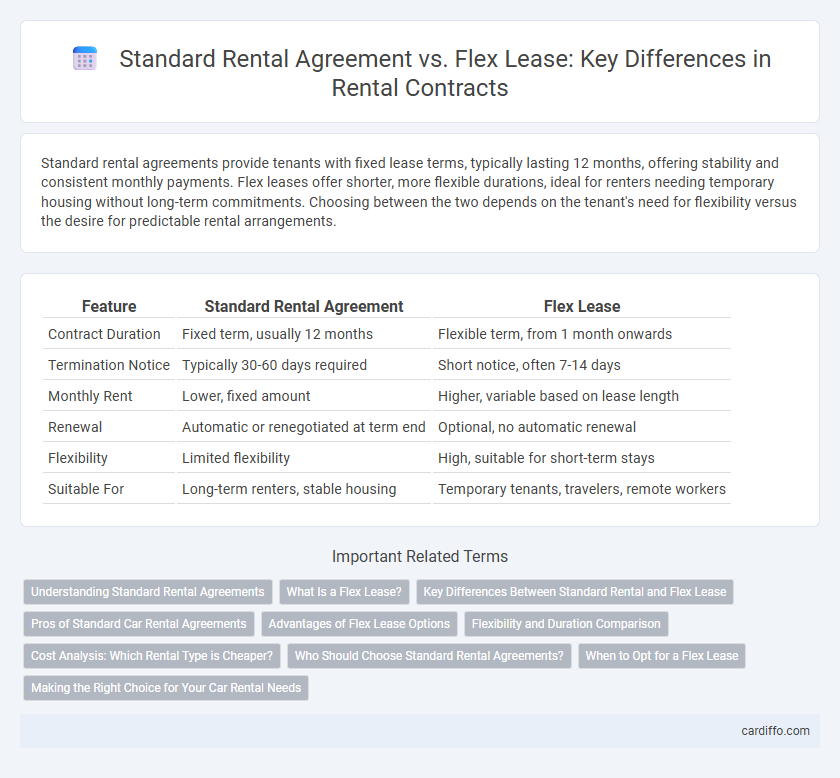Standard rental agreements provide tenants with fixed lease terms, typically lasting 12 months, offering stability and consistent monthly payments. Flex leases offer shorter, more flexible durations, ideal for renters needing temporary housing without long-term commitments. Choosing between the two depends on the tenant's need for flexibility versus the desire for predictable rental arrangements.
Table of Comparison
| Feature | Standard Rental Agreement | Flex Lease |
|---|---|---|
| Contract Duration | Fixed term, usually 12 months | Flexible term, from 1 month onwards |
| Termination Notice | Typically 30-60 days required | Short notice, often 7-14 days |
| Monthly Rent | Lower, fixed amount | Higher, variable based on lease length |
| Renewal | Automatic or renegotiated at term end | Optional, no automatic renewal |
| Flexibility | Limited flexibility | High, suitable for short-term stays |
| Suitable For | Long-term renters, stable housing | Temporary tenants, travelers, remote workers |
Understanding Standard Rental Agreements
Standard rental agreements provide a fixed-term lease, typically lasting 12 months, outlining specific rent amounts, tenant responsibilities, and landlord obligations to ensure legal clarity and predictability. These agreements often include clauses for maintenance, payment schedules, and penalties for early termination, offering both parties clear guidelines for the rental duration. Understanding the terms and conditions in a standard rental agreement helps tenants avoid unexpected fees and ensures landlords maintain consistent occupancy and rent collection.
What Is a Flex Lease?
A Flex Lease is a rental agreement designed to provide tenants with short-term or month-to-month leasing options, offering greater flexibility compared to a Standard Rental Agreement. Unlike traditional leases that typically require a fixed term of six months to a year, a Flex Lease allows tenants to adjust their stay duration without long-term commitment or heavy penalties. This lease type is ideal for individuals with uncertain timelines, such as remote workers, students, or those in transitional living situations.
Key Differences Between Standard Rental and Flex Lease
Standard rental agreements typically involve fixed terms, commonly lasting 12 months, with predetermined rent and penalties for early termination. Flex leases offer greater adaptability, allowing tenants to adjust lease duration and payment schedules to match fluctuating needs without severe penalties. The key differences lie in contract rigidity, payment flexibility, and tenant commitment, making flex leases ideal for short-term or uncertain housing situations.
Pros of Standard Car Rental Agreements
Standard rental agreements provide clear, fixed terms and predictable costs, making budgeting straightforward for renters. These agreements often include comprehensive insurance coverage and well-defined responsibilities, reducing potential disputes. Standard contracts also allow for easier comparison across rental companies, ensuring transparency and confidence in the rental process.
Advantages of Flex Lease Options
Flex lease options provide tenants with increased rental term flexibility, allowing for short-term or adjustable lease durations that cater to changing personal or business needs. These agreements often include more lenient termination clauses and renewal conditions, reducing penalties and fostering a stress-free rental experience. Flex leases can also offer greater adaptability in payment schedules and property usage, making them ideal for transient renters or businesses requiring scalable space solutions.
Flexibility and Duration Comparison
Flex Lease offers enhanced flexibility by allowing tenants to rent for shorter, customizable durations compared to the fixed-term commitments typically required in a Standard Rental Agreement. Unlike standard leases that usually span 12 months, Flex Leases can accommodate stays from a few weeks to several months, catering to temporary or uncertain housing needs. This adaptable duration makes Flex Leases ideal for individuals seeking convenience without long-term obligations.
Cost Analysis: Which Rental Type is Cheaper?
Standard Rental Agreements typically offer lower monthly rates and fixed costs, making them more cost-effective for long-term tenants. Flex Leases, while providing flexibility with shorter commitment periods, often come with higher monthly fees and additional premiums. Analyzing total expenses over the rental duration reveals that Standard Rental Agreements are generally cheaper for tenants intending to stay beyond six months.
Who Should Choose Standard Rental Agreements?
Standard rental agreements are ideal for tenants seeking long-term stability and predictable monthly payments, typically spanning 12 months or more. These agreements suit individuals with steady income who prefer fixed rental terms and clear responsibilities outlined in a contract. Homeowners and landlords also benefit from standard leases by minimizing tenant turnover and securing consistent rental income.
When to Opt for a Flex Lease
Opt for a Flex Lease when uncertain about the rental duration or anticipating frequent relocations, as it offers month-to-month flexibility without long-term commitments. Standard Rental Agreements commonly require fixed terms of six to twelve months, making them less adaptable for short-term housing needs. Flex Leases are ideal for professionals on temporary assignments or individuals in transitional life stages seeking convenience and reduced penalties for early termination.
Making the Right Choice for Your Car Rental Needs
Choosing between a Standard Rental Agreement and a Flex Lease depends on the duration and flexibility required for your car rental needs. Standard Rental Agreements offer fixed terms and predictable costs, ideal for short-term rentals and straightforward commitments, while Flex Leases provide customizable rental periods and mileage options suited for longer or variable use. Evaluating factors such as rental length, budget constraints, and usage patterns ensures you select the most cost-effective and convenient option for your specific situation.
Standard Rental Agreement vs Flex Lease Infographic

 cardiffo.com
cardiffo.com